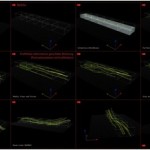Context-aware environments
In order to be more effective, virtual prototyping systems need to be able to understand changes in the context of the user and to deliver the right information at the right time on an as-needed basis[1]. This is the goal of context-aware virtual prototyping (Aziz, 2003). Aziz points out that: “the integration of context awareness and web services into virtual prototyping applications offers considerable potential for enhancing their versatility and ensuring that end-users are provided with access to context-specific data, information and services. The context parameters that need to be incorporated can be defined by the project team based on the requirements of each project. These will include some of the user-context parameters (e.g. role, discipline, interests, preferences, etc.) as well as project parameters (e.g. project stage, client requirements, project location, procurement/contract type, technical/design requirements – with respect to issues such as sustainability, cost, quality, function, etc.).” It is clear that we are dealing here with multiple points of view, where user needs ontologies that provide a common understanding of key concepts, such that reasoning can be undertaken based on the interpreted context and intelligent action taken.
According to Aziz, in order to effectively share knowledge the adaptation and enablement of specific factors and technologies to design is inevitable:
- “Knowledge and practice pattern recognition: Mechanisms and tools to identify, for example, usage patterns in the execution of a particular task using some application. These patterns may then be used by application wizards to help users in the execution of such tasks (e.g. provision of the first ten steps) without the user having to navigate through complex menus.
- Context- and knowledge-aware applications: Applications that are context-sensitive and can recognize what the user is aiming to do. They should thence be able to provide appropriate guidance, menus and make available the relevant information.
- Comprehensive and intelligent product libraries: Intelligent digital catalogues of useful products. They should contain substantial product information (much more than simple geometry) in parametric form. As an example, they could contain built-in support for engineering analysis and product configuration, and guidelines for the work implementation of the product.
- Knowledge portals (KM environments): KM environments at an industry level are needed to enable individuals retrieve shared best practices and experiences. These should ideally be transparent to the users and be accessible by different applications and search services. Furthermore, they should provide relevant groupware functionality at an industry (e.g. network of experts) level.
- High level semantic representations through ontology: These will help with the identification of key concepts and their interrelationships. Ontologies should not be too generic or too large. Rather, life cycle phases, or specific topics should be developed in detail. A meta-ontology should be built on top of these to allow for interoperability and mapping between these ontologies when and where needed.
- Knowledge-related services: These services should facilitate inter-enterprise knowledge management through the provision of simple services such as searching, and sophisticated services. These services may be subscribed to on an as-need basis.” Aziz (2003)
Hanser (PhD diss., Institute National Polytechnique de Lorraine, 2003) argues that “design in the construction sector and, more particularly, design project management are social and professional activities characterized by a specific cooperation context. However, the available collaborative tools are not adapted to this context. Indeed, the collaborative and distributed design requires a cognitive synchronization based on ‘unplanned’ activities that he qualifies as ‘implicit’ activities. Autonomous actors, belonging to one or more entities, realize these activities with varied and complementary competences. In this group, the actors cooperate in order to achieve a common objective, which can be the production of a document, a product or a building.”
According to Aziz advances in information and communication technologies are expected to bring major contributions in the following areas:
- “Knowledge mining: Tools for the retrieval of knowledge (including business logic and rules) from different information sources and applications. This should be automated, with the captured business logic and rules made reusable in the form of application components.
- Meta repositories: These will provide definitions of, and relationships and mappings between, different information repositories, knowledge sources and ontologies. As an example, through their support, when a search is made for a particular item (e.g. a standard), then only one instance of that standard will be retrieved with a note that the same is also available in given locations. In simple terms, instead of hundreds of links/pointers to the same information, only one direct link to the source of information will be provided.
- Semantic web: This will enable a paradigm shift in the way individuals, and particularly applications, solicit information from the Internet. As opposed to human interpretable web content, annotations and intelligence will be added to content for ease of retrieval and interpretation by different applications.
- Knowledge agents: Intelligent knowledge agents will act as a transient entity between individuals and/or applications and knowledge sources. They will (if necessary through automation) be able to modify and adjust queries to retrieve the required information from the relevant sources. Furthermore, the results may be ranked and categorized (automatically) based on the typical preferences of the user/application. Many more such applications of knowledge agents can be envisaged.
- Ambient access technologies: Ubiquitous, personalized and context-dependent access to knowledge is necessary and will be provided through ambient access technologies. These technologies will be based on an integrated use of ontologies, semantic web, context-aware applications, knowledge processes, personal usage patterns, mobility, etc.” Aziz (2003)
[1] Zeeshan Aziz, “Semantic web based services for intelligent mobile construction collaboration”, ITcon 9 (Special Issue: Mobile Computing in Construction, 2003), 367-379











You must be logged in to post a comment.